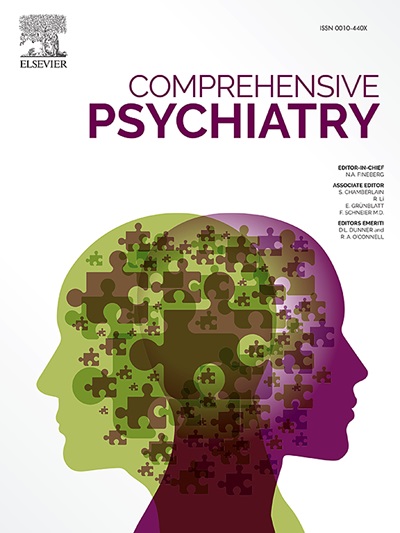中国青少年问题游戏与嗜睡之间的前瞻性关联:跨滞后面板网络模型的启示。
IF 4.2
2区 医学
Q1 PSYCHIATRY
引用次数: 0
摘要
背景和目的:以往的研究局限于通过横断面研究来探讨问题游戏和嗜睡症状之间时间关系的方向性。因此,我们估计了青春期包括问题游戏和嗜睡在内的个体行为成瘾症状之间的纵向关系,并探讨了这些关系中潜在的性别差异:本研究纳入了中国山东省的 3296 名参与者。数据收集时间为 2021 年 11 月(平均 [SD] 年龄:15.17 [1.44] 岁)至 2023 年 5 月(平均 [SD] 年龄:17.50 [1.18] 岁),其中女性占样本的 54.5%。每次调查都使用经过验证的量表对有问题的游戏和网络游戏进行评估。我们构建了横截面网络和跨滞后面板网络(CLPN),以探讨问题游戏和幽会之间的蔑视和时间关系:结果:同期网络显示,男性和女性之间的问题游戏和泡吧网络存在显著差异。此外,时间网络分析显示,在男性青少年中,无法玩游戏时的焦虑感是对随后行为成瘾症状最有影响力的预测因素。对于女性青少年来说,对游戏的幻想与未来成瘾行为的关联最为显著。对于男女青少年来说,将问题游戏和嗜睡联系起来的最强烈的桥梁症状是专注于手机而不是进行交谈:该研究将网络建模应用于一个大型的、以人群为基础的青少年队列的面板数据中,发现了问题游戏和嗜睡之间在症状领域的独特纵向关系。该研究对青少年行为成瘾症状的特征以及这些症状在不同性别间的潜在预测关系提供了有价值的见解,从而为针对不同性别青少年的针对性干预措施提供指导。本文章由计算机程序翻译,如有差异,请以英文原文为准。
The prospective associations between problematic gaming and phubbing among Chinese adolescents: Insights from a cross-lagged panel network model
Background and aims
Previous studies are limited in addressing the directionality of temporal relationships between problematic gaming and phubbing symptoms by exploring cross-sectional studies. Therefore, we estimated the longitudinal relationships between individual behavioral addictive symptoms including problematic gaming and phubbing in adolescence, and explored potential sex differences in these relationships.
Methods
This study included 3296 participants in Shandong Province, China. Data were collected from November 2021 (mean [SD] age: 15.17 [1.44] years) to May 2023 (mean [SD] age: 17.50 [1.18] years), with females comprising 54.5 % of the sample. Problematic gaming and phubbing were assessed using validated scales at each wave. We construct cross-sectional networks and cross-lagged panel networks (CLPN) to explore the contemptuous and temporal relationships between problematic gaming and phubbing.
Results
Contemporaneous networks revealed significant differences in problematic gaming and phubbing networks between males and females. Additionally, temporal network analyses indicated that among male adolescents, feeling anxious when unable to play games was the most influential predictor of subsequent behavioral addictive symptoms. For female adolescents, fantasizing about gaming had the most significant associations with future addictive behaviors. The strongest bridge symptom linking problematic gaming and phubbing for both sexes was focusing on phones rather than engaging in conversation.
Discussion and conclusions
The study applied network modeling to panel data from a large, population-based cohort of adolescents, identifying unique longitudinal relationships between problematic gaming and phubbing across symptom domains. It provides valuable insights into the characterization of behavioral addictive symptoms among adolescents and the potential predictive relationships among these symptoms among different sexes, guiding sex-specific targeted interventions for adolescents.
求助全文
通过发布文献求助,成功后即可免费获取论文全文。
去求助
来源期刊

Comprehensive psychiatry
医学-精神病学
CiteScore
12.50
自引率
1.40%
发文量
64
审稿时长
29 days
期刊介绍:
"Comprehensive Psychiatry" is an open access, peer-reviewed journal dedicated to the field of psychiatry and mental health. Its primary mission is to share the latest advancements in knowledge to enhance patient care and deepen the understanding of mental illnesses. The journal is supported by a diverse team of international editors and peer reviewers, ensuring the publication of high-quality research with a strong focus on clinical relevance and the implications for psychopathology.
"Comprehensive Psychiatry" encourages authors to present their research in an accessible manner, facilitating engagement with clinicians, policymakers, and the broader public. By embracing an open access policy, the journal aims to maximize the global impact of its content, making it readily available to a wide audience and fostering scientific collaboration and public awareness beyond the traditional academic community. This approach is designed to promote a more inclusive and informed dialogue on mental health, contributing to the overall progress in the field.
 求助内容:
求助内容: 应助结果提醒方式:
应助结果提醒方式:


